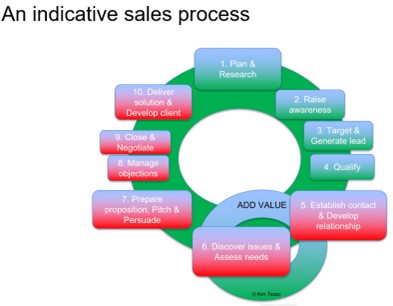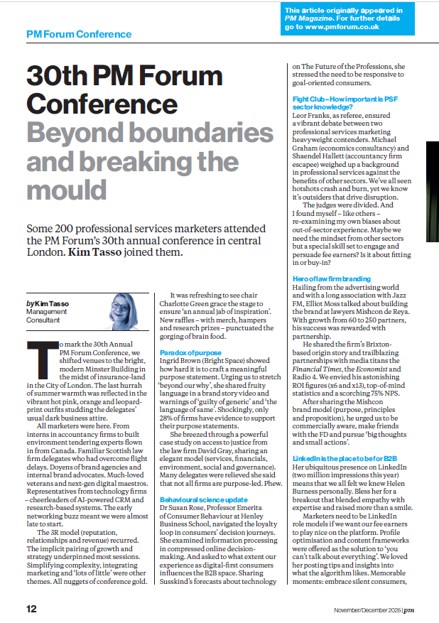During the inevitable end of year office tidy up I came across a briefing paper called “The State of Marketing” written by the wonderful Professor McDonald (I call him the “Patron Saint of Marketing Plans”) for the Cambridge Marketing College in 2009 and thought it was worth reviewing his thoughts a year down the line. So here’s a summary of how Marketing needs to be more accountable – Malcolm McDonald style.
Importance of market growth
The paper starts with a focus on market growth rates and poses two critical questions “What are your key target markets in order of priority?” and “What are your company’s sources of differential advantage in each of these key target markets?”. Tough questions for most but essential, he argues, in times when we can’t “merely be dragged along by the momentum of growth”.
He then talks about “Anorexia Industrialosa” – the excessive desire to be leaner and fitter. Well, we’ve all seen that in the professions. But he reminds us that in excess it can lead to emaciation and eventually death. He uses Mark Ritson’s quote that “great stars shine brightest when the sky is darkest” to remind us that in austere times “great brands, bestow pleasure, maintain their premium and take a long view”.
Marketing in the doldrums
He talks about marketing’s recent lack of academic assessment, its reputation for promoting an acquisitive and materialistic society and its demotion to the role of promotion and puffery. He quotes from the Deloitte report: “Marketers have constantly hidden behind a fog of measures that are based purely on tactical marketing activity rather than solid financial metrics that are relevant to the City”.
He points to three key issues:
- The name “marketing” itself
- Making our profession truly professional
- The need to be fully accountable and add shareholder value
Name confusion and a lack of qualifications
He starts from a former CIM president’s statement that “Marketing isn’t a function. It is an attitude of mind” whilst pointing out that there are at least 30 different definitions of marketing. He sets the record straight – with statements that will be familiar to all qualified marketers – by stating that marketing is a process for:
- Defining markets in terms of needs
- Quantifying the needs of the customer groups (segments) within these markets
- Putting together the value propositions to meet these needs and communicating these value propositions to all those people in the organisation responsible for delivering them
- Playing an appropriate part in delivering these value propositions
- Monitoring the value actually delivered
He is careful to separate out those steps relating to strategy determination and those that focus on tactical implementation and measurement. The latter are sadly those that have come to represent marketing as a function – partly because of the million people in the UK who “mascarade” as marketers (including sales people, copywriters, advertisers, direct mailers, researchers etc) only a minute percentage are qualified.
This is in marked contrast to other professions such as law and accountancy, where a professional qualification is only the starting point for entry. No surprises that he calls on bodies such as CIM and the Academy of Marketing to lead a campaign to ensure that all marketers are qualified and licensed to practice.
Accountability
He argues that marketing needs to become more accountable and looks at the various ways this can be tackled.
Add shareholder value
Strategies for the longer term (three to five years) must increase shareholder value taking into account the risks, the time value and the cost of capital. It requires assets to be managed strategically – and this is difficult when most of them are not on the balance sheet as they are intangible. He provides numerous statistics to show the growing importance of intangible assets – including the fact that in the UK and USA over 80% of the value of companies resides in intangibles. Then he points to the numerous efforts to assess quantitatively whether a company’s future strategy will create or destroy shareholder value and the importance of consumers and market reaction and thus risk.
Marketing due diligence begins by looking for the risk associated with a strategy and there are three areas where companies fail to keep their promises: market not as big as thought, company fails to get the market share it hoped for and the company doesn’t get the profit it hoped for. He provides a method of sub-dividing business risk into as many sources as practically possible – he found 15 – estimating them separately and then recombining them.
Link activities and attitudes to outcomes
He reminds us that the output of marketing can be measured only a long while after “it has left the plant”. He suggests that a useful starting point in linking activities to corporate financial objectives is the Ansoff matrix – so each segment (and product) looks at the critical success factors and volume, value and profit generated. He also remarks on hygiene factors (standards to be achieved by any competitor in the market), productivity factors and lead and lag factors. Together these provide a way to allocate expenditure to improve CSFs.
Micro measurement
Despite the numerous tools and techniques to measure promotional activity, awareness and attitude change it is becoming more difficult. He argues that rather than look at discounted cash flows against the current situation, they should be against the more likely scenario of a decline in performance in the absence of the promotional investment.
He provides interesting support from the IPA which analysed 900 promotional campaigns – in one scenario the promotional budget was cut to zero for a year then returned to normal, whilst in another it was cut by 50%. Sales recovery to pre-cut levels took five years and three years respectively.
He thus argues for calculations on the level of investment required to maintain the status quo and the additional investment needed over and above that and then a NPV (Net Present Value) calculation on the anticipated net free cash flows above the present cash flows from maintenance expenditure.
Personally, I don’t think his important message about accountability has been heard or heeded. Cuts to the marketing and business development budgets in the professions continue. But perhaps we are to blame for failing to encourage our profession to research and develop the necessary tools to help us make a clear financial case for the level of market expenditure we need to both sustain and grow our profits.
So Marketing needs to be more accountable – Malcolm McDonald. It looks like one of my New Year’s Resolutions will be to explore ways to brush up my numeracy skills, cosy up to my accountancy friends and develop more robust financial tools and metrics for my clients.
Happy New Year!
Other posts mentioning Malcolm McDonald:
“The State of the Marketing Profession – Past, Present and Future” (kimtasso.com) May 2020
Book Review: Malcolm McDonald on value propositions – How to develop them, how to quantify them (by Malcolm McDonald and Grant Oliver) May 2019









